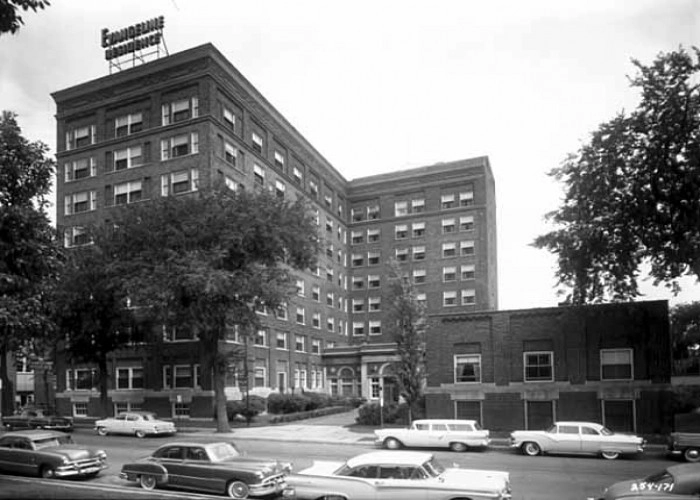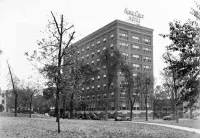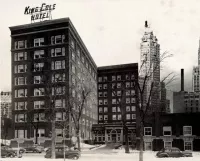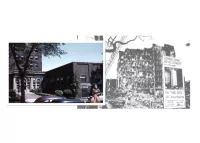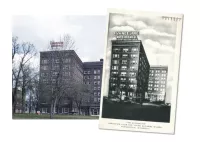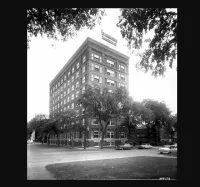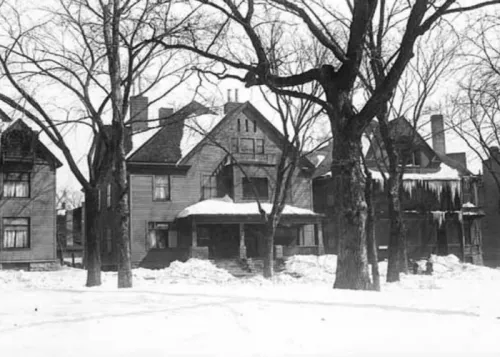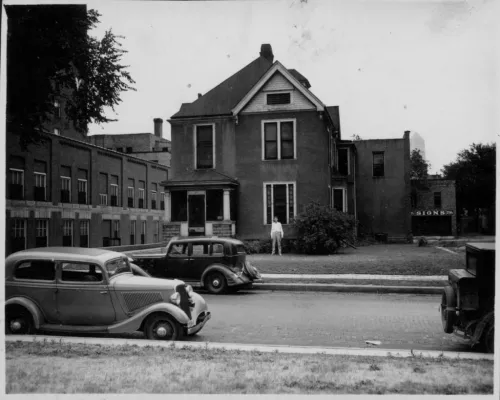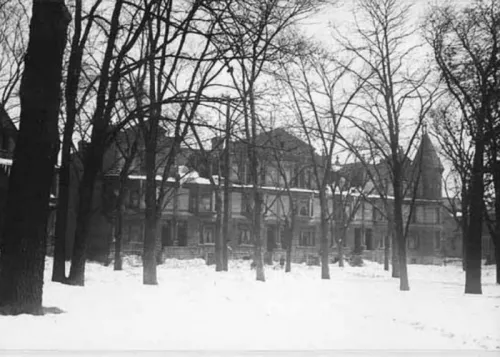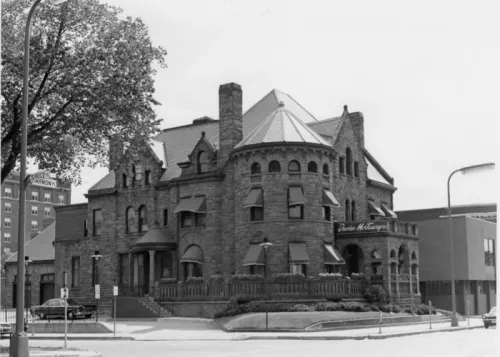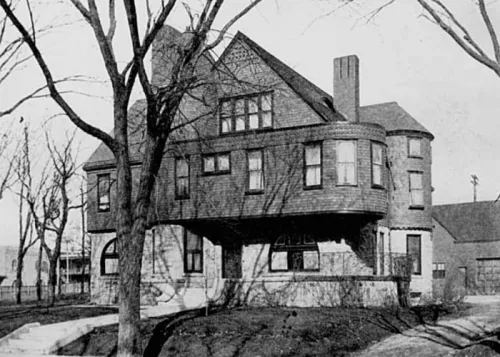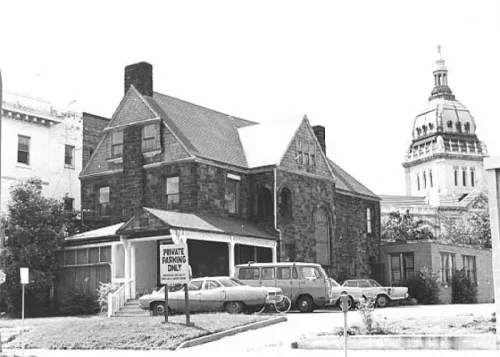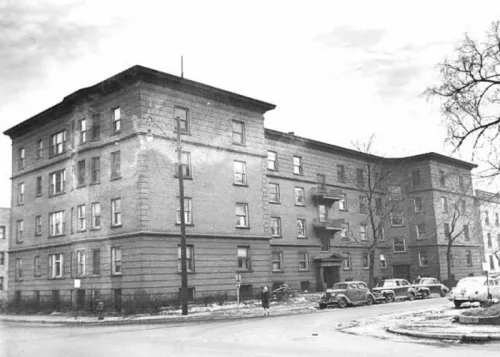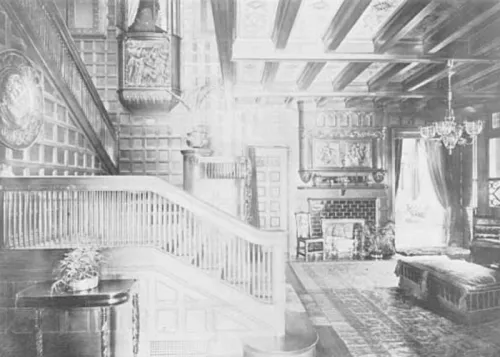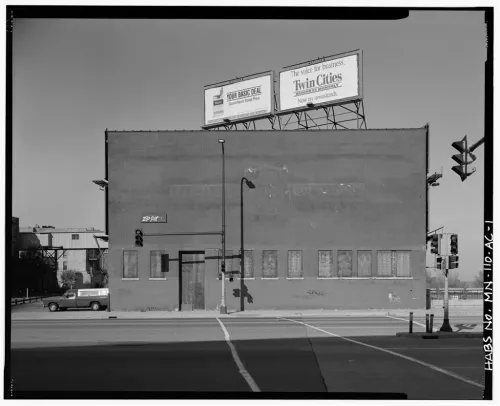Share what you know,
and discover more.
Share what you know,
and discover more.
Mar 01, 2022
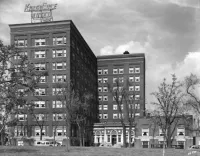
-

- Dave D
King Cole Hotel
King Cole Hotel In October 1934 the building was purchased by Peppard Properties, Inc. The new owner conducted a contest for a name and King Cole was chosen when the hotel opened on December 1, 1934. (Minneapolis Star, January 24, 1949). However, a search of the Minneapolis papers finds a mention the King Cole Hotel on February 13, 1926. A different King Cole Hotel? Must be an anomaly, since the next mentions don’t start until January 1935. Cedar Imboden Phillips has described it as “a destination for countless local celebrations and special events,” presumably with music involved. The social columns noted that guests to town stayed at the hotel; notorious guests included Bugsy Siegel, according to Phillips. Meetings were held there, and in the mid-1930s more dances began to be held at the hotel. These were all private affairs, sponsored by such groups as the Hanky Panky Club, an organization of magicians. Other common events were wedding receptions, class reunions, fraternity and sorority dances, etc. In 1935, the murder of journalist Arthur Liggett spurred several police investigations. One was by the “Secret Six,” a group out of Chicago, headquartered at the King Cole Hotel. (Minneapolis Star, December 11, 1935) In 1937 advertisements began to appear, telling us that the hotel had a swimming pool, “physical culture studio,” and a famous dining room. The hotel made much of its pool, offering swimming lessons. In 1949 the building was purchased by the Salvation Army, which converted it into the Evangeline Residence for Girls, a residence for women between the ages of 17 and 35. Weekly rates started at $14 per week. The building was wrecked in 1976 and replaced by Booth Manor, a senior high-rise also owned by the Salvation Army. Photos: 1935 photo courtesy Hennepin County Library, May 12, 1936 photo courtesy Minnesota Historical Society
King Cole Hotel
King Cole Hotel In October 1934 the building was purchased by Peppard Properties, Inc. The new owner conducted a contest for a name and King Cole was chosen when the hotel opened on December 1, 1934. (Minneapolis Star, January 24, 1949). However, a search of the Minneapolis papers finds a mention the King Cole Hotel on February 13, 1926. A different King Cole Hotel? Must be an anomaly, since the next mentions don’t start until January 1935. Cedar Imboden Phillips has described it as “a destination for countless local celebrations and special events,” presumably with music involved. The social columns noted that guests to town stayed at the hotel; notorious guests included Bugsy Siegel, according to Phillips. Meetings were held there, and in the mid-1930s more dances began to be held at the hotel. These were all private affairs, sponsored by such groups as the Hanky Panky Club, an organization of magicians. Other common events were wedding receptions, class reunions, fraternity and sorority dances, etc. In 1935, the murder of journalist Arthur Liggett spurred several police investigations. One was by the “Secret Six,” a group out of Chicago, headquartered at the King Cole Hotel. (Minneapolis Star, December 11, 1935) In 1937 advertisements began to appear, telling us that the hotel had a swimming pool, “physical culture studio,” and a famous dining room. The hotel made much of its pool, offering swimming lessons. In 1949 the building was purchased by the Salvation Army, which converted it into the Evangeline Residence for Girls, a residence for women between the ages of 17 and 35. Weekly rates started at $14 per week. The building was wrecked in 1976 and replaced by Booth Manor, a senior high-rise also owned by the Salvation Army. Photos: 1935 photo courtesy Hennepin County Library, May 12, 1936 photo courtesy Minnesota Historical Society
Mar 01, 2022
King Cole Hotel
King Cole HotelIn October 1934 the building was purchased by Peppard Properties, Inc. The new owner conducted a contest for a name and King Cole was chosen when the hotel opened on December 1, 1934. (Minneapolis Star, January 24, 1949).
However, a search of the Minneapolis papers finds a mention the King Cole Hotel on February 13, 1926. A different King Cole Hotel? Must be an anomaly, since the next mentions don’t start until January 1935.
Cedar Imboden Phillips has described it as “a destination for countless local celebrations and special events,” presumably with music involved. The social columns noted that guests to town stayed at the hotel; notorious guests included Bugsy Siegel, according to Phillips. Meetings were held there, and in the mid-1930s more dances began to be held at the hotel. These were all private affairs, sponsored by such groups as the Hanky Panky Club, an organization of magicians. Other common events were wedding receptions, class reunions, fraternity and sorority dances, etc.
In 1935, the murder of journalist Arthur Liggett spurred several police investigations. One was by the “Secret Six,” a group out of Chicago, headquartered at the King Cole Hotel. (Minneapolis Star, December 11, 1935)
In 1937 advertisements began to appear, telling us that the hotel had a swimming pool, “physical culture studio,” and a famous dining room. The hotel made much of its pool, offering swimming lessons.
In 1949 the building was purchased by the Salvation Army, which converted it into the Evangeline Residence for Girls, a residence for women between the ages of 17 and 35. Weekly rates started at $14 per week.
The building was wrecked in 1976 and replaced by Booth Manor, a senior high-rise also owned by the Salvation Army.
Photos: 1935 photo courtesy Hennepin County Library, May 12, 1936 photo courtesy Minnesota Historical Society
Posted Date
Mar 17, 2022
Historical Record Date
Mar 01, 2022
Source Name
Twin Cities Music Highlights
Delete Story
Are you sure you want to delete this story?
Jun 12, 2017
Jun 12, 2017
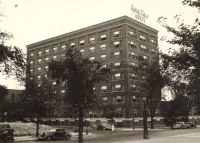
-

- Dave D
A Loring Park destination
A Loring Park destination By Cedar Imboden Phillips JUNE 12, 2017 The News Source for Downtown & Northeast Minneapolis Residents Photograph courtesy Hennepin History Museum. The eight-story King Cole Hotel welcomed hundreds of guests each night during the 1920s through 1940s. Standing at the corner of Willow Street and Yale Place overlooking Loring Park, the hotel was a destination for countless local celebrations and special events. Overnight guests included both visitors passing through as well as long-term residents. Bugsy Siegel slept here. The Salvation Army purchased the building in 1949 and converted it to the Evangeline Residence for Girls, a residential home for professional women between the ages of 17 and 35 with weekly rates starting at $14 per week. The building was demolished in 1976 and replaced by the Booth Manor, a Salvation Army-owned senior high-rise.
A Loring Park destination
A Loring Park destination By Cedar Imboden Phillips JUNE 12, 2017 The News Source for Downtown & Northeast Minneapolis Residents Photograph courtesy Hennepin History Museum. The eight-story King Cole Hotel welcomed hundreds of guests each night during the 1920s through 1940s. Standing at the corner of Willow Street and Yale Place overlooking Loring Park, the hotel was a destination for countless local celebrations and special events. Overnight guests included both visitors passing through as well as long-term residents. Bugsy Siegel slept here. The Salvation Army purchased the building in 1949 and converted it to the Evangeline Residence for Girls, a residential home for professional women between the ages of 17 and 35 with weekly rates starting at $14 per week. The building was demolished in 1976 and replaced by the Booth Manor, a Salvation Army-owned senior high-rise.
A Loring Park destination
A Loring Park destinationBy Cedar Imboden Phillips
JUNE 12, 2017
The News Source for Downtown & Northeast Minneapolis Residents
Photograph courtesy Hennepin History Museum.
The eight-story King Cole Hotel welcomed hundreds of guests each night during the 1920s through 1940s. Standing at the corner of Willow Street and Yale Place overlooking Loring Park, the hotel was a destination for countless local celebrations and special events. Overnight guests included both visitors passing through as well as long-term residents. Bugsy Siegel slept here. The Salvation Army purchased the building in 1949 and converted it to the Evangeline Residence for Girls, a residential home for professional women between the ages of 17 and 35 with weekly rates starting at $14 per week. The building was demolished in 1976 and replaced by the Booth Manor, a Salvation Army-owned senior high-rise.
Posted Date
Mar 17, 2022
Historical Record Date
Jun 12, 2017
Source Name
The Journal
Source Website
Delete Story
Are you sure you want to delete this story?
Jul 13, 2011
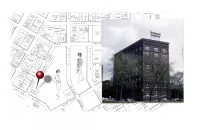
-

- Dave D
Residing at Evangeline
This 8 story building overlooking Loring Park at the corner Willow and Yale began its short life as the Nordic Hotel. Originally planned as a hospital. that was never completed it was purchased and finished by the Nordic Hotel Association in 1929. The exterior facing was of brick and Bedford stone trim. It contained 189 rooms. The L shaped structure inspired the Nordic Hotel to call for eventual construction of an additional eight story tower, but only two stories were ever erected. The hotel contained a library, donated by an anonymous Norwegian educator. The building was planned as a Norwegian memorial structure. John C. Kuck and company are financed the project. A couple years after these auspicious beginnings, the Great Depression scuttled everything and the one million dollar project was up on the auction block for $200,000. The construction company officials couldn’t decide whether to complete the building or dispose of it. The fledgling Nordic Hotel was eventually purchased and completed by Peppard Properties Incorporated. The company spent another million dollars furnishing the building, decorating and installing, in the unfinished section of the basement a complete gymnasium, swimming pool, billiard room and other features. At the time Peppard also operated the Admiral and Parkway hotels and a number of apartment and business properties in Minneapolis. In 1949 the King Cole was purchased by the Salvation Army for $568,000 and the former hotel was converted into a “Christian home away from home for girls”. The aim was to provide for young women, fresh off the farm and working downtown. The building was renamed the Evangeline Residence and opening ceremonies featured Minnesota Governor Luther W. Youngdahl and Minneapolis Mayor Eric C. Hoyner. Rooms at the Evangeline went for as little as $14.00 a week. In 1976, the Evangeline was torn down to make way for the Salvation Army’s Booth Manor senior citizen’s high rise. The 21-story building, named for William Booth, founder of the Salvation Army, still houses moderate-income seniors on Loring Park in 156 one and two bedroom apartments. City officials originally took a glance at the possibility of remodeling the Evangeline Residence but decided that building a brand spanking new $3.3-million high-rise would be more economical.
Residing at Evangeline
This 8 story building overlooking Loring Park at the corner Willow and Yale began its short life as the Nordic Hotel. Originally planned as a hospital. that was never completed it was purchased and finished by the Nordic Hotel Association in 1929. The exterior facing was of brick and Bedford stone trim. It contained 189 rooms. The L shaped structure inspired the Nordic Hotel to call for eventual construction of an additional eight story tower, but only two stories were ever erected. The hotel contained a library, donated by an anonymous Norwegian educator. The building was planned as a Norwegian memorial structure. John C. Kuck and company are financed the project. A couple years after these auspicious beginnings, the Great Depression scuttled everything and the one million dollar project was up on the auction block for $200,000. The construction company officials couldn’t decide whether to complete the building or dispose of it. The fledgling Nordic Hotel was eventually purchased and completed by Peppard Properties Incorporated. The company spent another million dollars furnishing the building, decorating and installing, in the unfinished section of the basement a complete gymnasium, swimming pool, billiard room and other features. At the time Peppard also operated the Admiral and Parkway hotels and a number of apartment and business properties in Minneapolis. In 1949 the King Cole was purchased by the Salvation Army for $568,000 and the former hotel was converted into a “Christian home away from home for girls”. The aim was to provide for young women, fresh off the farm and working downtown. The building was renamed the Evangeline Residence and opening ceremonies featured Minnesota Governor Luther W. Youngdahl and Minneapolis Mayor Eric C. Hoyner. Rooms at the Evangeline went for as little as $14.00 a week. In 1976, the Evangeline was torn down to make way for the Salvation Army’s Booth Manor senior citizen’s high rise. The 21-story building, named for William Booth, founder of the Salvation Army, still houses moderate-income seniors on Loring Park in 156 one and two bedroom apartments. City officials originally took a glance at the possibility of remodeling the Evangeline Residence but decided that building a brand spanking new $3.3-million high-rise would be more economical.
Jul 13, 2011
Residing at Evangeline
This 8 story building overlooking Loring Park at the corner Willow and Yale began its short life as the Nordic Hotel. Originally planned as a hospital. that was never completed it was purchased and finished by the Nordic Hotel Association in 1929. The exterior facing was of brick and Bedford stone trim. It contained 189 rooms. The L shaped structure inspired the Nordic Hotel to call for eventual construction of an additional eight story tower, but only two stories were ever erected. The hotel contained a library, donated by an anonymous Norwegian educator.The building was planned as a Norwegian memorial structure. John C. Kuck and company are financed the project. A couple years after these auspicious beginnings, the Great Depression scuttled everything and the one million dollar project was up on the auction block for $200,000. The construction company officials couldn’t decide whether to complete the building or dispose of it. The fledgling Nordic Hotel was eventually purchased and completed by Peppard Properties Incorporated. The company spent another million dollars furnishing the building, decorating and installing, in the unfinished section of the basement a complete gymnasium, swimming pool, billiard room and other features. At the time Peppard also operated the Admiral and Parkway hotels and a number of apartment and business properties in Minneapolis.
In 1949 the King Cole was purchased by the Salvation Army for $568,000 and the former hotel was converted into a “Christian home away from home for girls”. The aim was to provide for young women, fresh off the farm and working downtown. The building was renamed the Evangeline Residence and opening ceremonies featured Minnesota Governor Luther W. Youngdahl and Minneapolis Mayor Eric C. Hoyner. Rooms at the Evangeline went for as little as $14.00 a week. In 1976, the Evangeline was torn down to make way for the Salvation Army’s Booth Manor senior citizen’s high rise. The 21-story building, named for William Booth, founder of the Salvation Army, still houses moderate-income seniors on Loring Park in 156 one and two bedroom apartments. City officials originally took a glance at the possibility of remodeling the Evangeline Residence but decided that building a brand spanking new $3.3-million high-rise would be more economical.
Posted Date
Mar 17, 2022
Historical Record Date
Jul 13, 2011
Source Name
Nokohaha
Source Website
Delete Story
Are you sure you want to delete this story?
Sep 04, 1958
Sep 04, 1958
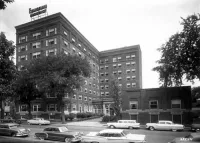
60 Willow Street, Minneapolis, MN, USA
Evangeline Residence, 60 Willow, Minneapolis Photographer: Norton & Peel Forms part of Norton & Peel photograph collection. Client: Evangeline Residence Content: 09/04/1958
60 Willow Street, Minneapolis, MN, USA
Evangeline Residence, 60 Willow, MinneapolisPhotographer: Norton & Peel
Forms part of Norton & Peel photograph collection.
Client: Evangeline Residence
Content: 09/04/1958
Posted Date
Mar 17, 2022
Historical Record Date
Sep 04, 1958
Source Name
Minnesota Historical Society
Delete Story
Are you sure you want to delete this story?
